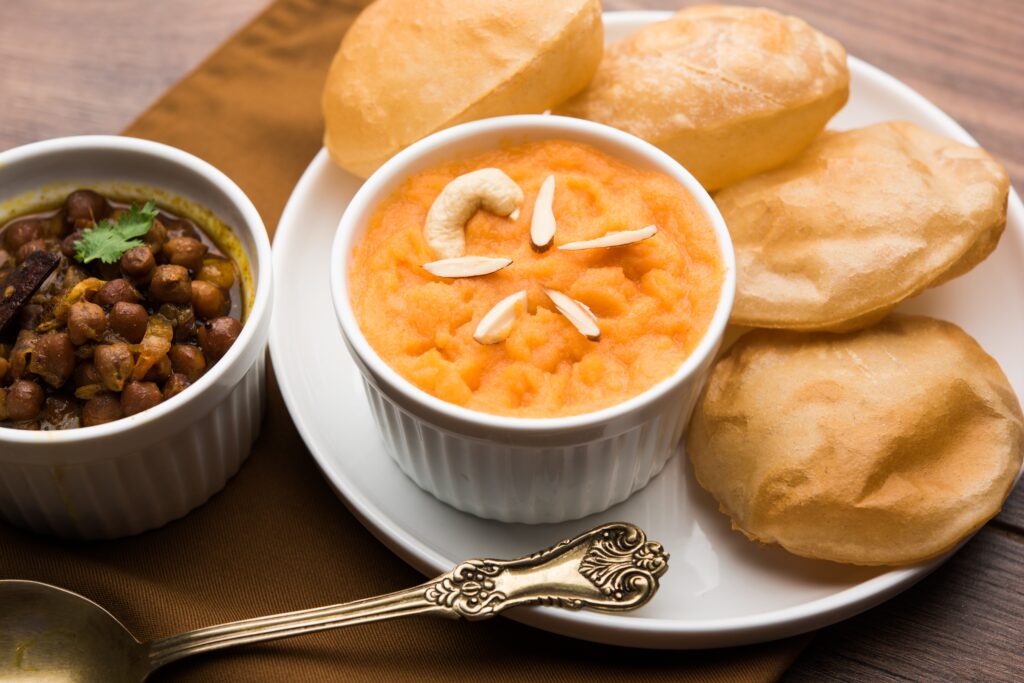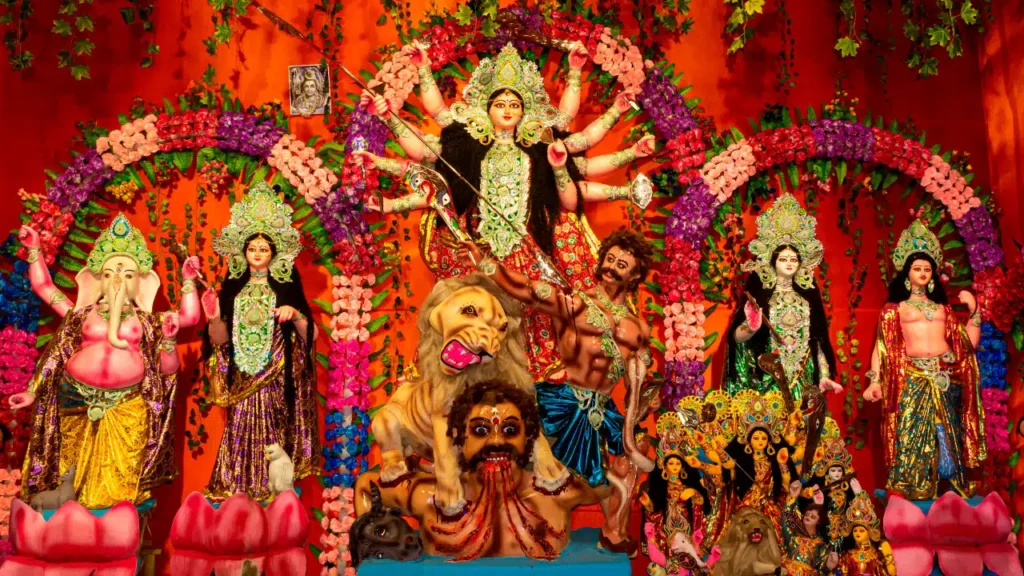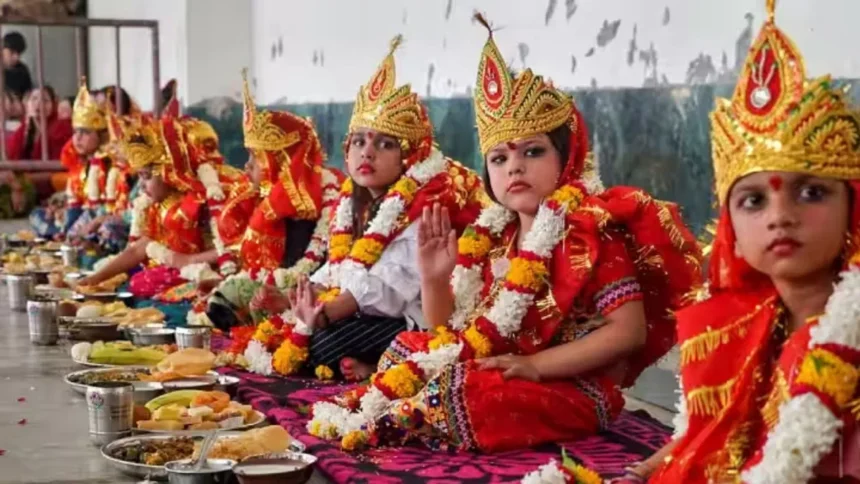The Sacred Power of Durga Ashtami
Durga Ashtami, one of the most sacred days in the Hindu calendar, embodies the spirit of Shakti — the divine feminine energy. Celebrated with immense devotion across India, this day marks the triumph of Goddess Durga over the demon Mahishasura — symbolizing the eternal victory of good over evil.
In 2025, Durga Ashtami will be celebrated with grandeur across India, reflecting the nation’s spiritual diversity, cultural heritage, and unwavering faith. Beyond religious observance, it connects millions of Indians to timeless values of courage, purity, and resilience.
Durga Ashtami is not just a festival; it’s a living expression of India’s unity in diversity — where every region celebrates the Goddess in its own unique style, yet with a shared devotion.
Historical Significance: The Legend Behind Durga Ashtami
According to ancient Hindu scriptures, Goddess Durga was created by the combined powers of Brahma, Vishnu, and Mahesh to destroy the mighty demon Mahishasura, who threatened the balance of the universe. The fierce battle that ensued lasted for nine days and nights, culminating on the eighth day — Ashtami, when Maa Durga emerged victorious.
This day signifies the triumph of righteousness (Dharma) over Adharma (injustice). Each form of the Goddess — from Shailaputri to Mahagauri — represents different strengths and virtues essential to overcome life’s challenges.
Durga Ashtami also symbolizes women’s empowerment — celebrating feminine divinity and strength, reminding society that women are not just nurturers but also protectors.
Spiritual Meaning and Symbolism of Durga Ashtami
Durga Ashtami goes beyond worship and rituals; it’s a festival of inner awakening. The Goddess represents the divine force within every human that helps overcome negativity, fear, and doubt.
In spiritual terms, the nine forms of Durga symbolize different stages of spiritual evolution. On Ashtami, the focus is on Mahagauri, the eighth form, who embodies purity, calmness, and compassion. Devotees believe that worshiping her removes past sins and grants mental peace.
The festival teaches that every battle — internal or external — can be won with courage, truth, and self-belief.
How India Celebrates Durga Ashtami 2025
In West Bengal, Durga Ashtami is the heart of Durga Puja — marked by grand pandals, artistic idols, and the famous “Pushpanjali” (flower offering) ritual. Women wear traditional sarees, and the rhythmic sound of dhak drums fills the air with energy.
- In Delhi and North India, devotees observe fasting and perform Kanya Puja, where young girls (symbolizing the Goddess) are worshipped with devotion, offered prasad, and gifted new clothes.
- In South India, Ashtami is observed as part of Navaratri Golu, with beautifully decorated steps displaying deities and mythological scenes.
- In Gujarat, the day is celebrated with Garba and Dandiya nights — symbolizing devotion through dance and joy.
- In Odisha and Assam, communities gather for temple rituals, prayers, and spiritual discourses.

Rituals and Puja Vidhi for Durga Ashtami 2025
- Morning Puja: Devotees wake up early, bathe, and set up the idol or image of Goddess Durga on a clean altar decorated with flowers, incense, and lamps.
- Pushpanjali: Fresh flowers are offered while chanting the sacred mantras from the Durga Saptashati.
- Sandhi Puja: The transition period between Ashtami and Navami is considered highly auspicious. It is believed that during this time, Maa Durga transformed into Chamunda to slay Chanda and Munda, the two generals of Mahishasura.
- Kanya Puja: Nine young girls representing the Navadurga are worshipped. Their feet are washed, and they are offered food, gifts, and blessings.
- Fasting: Many devotees observe strict fasting, consuming only fruits and milk throughout the day to maintain spiritual discipline.
These rituals are not just acts of devotion but symbolize discipline, faith, and the purification of the soul.
Durga Ashtami in Modern India: Tradition Meets Technology
In 2025, India’s celebrations of Durga Ashtami are expected to blend ancient rituals with modern technology.
Virtual darshans, live-streamed aartis, and digital pandal tours are helping devotees connect globally. Social media campaigns are spreading awareness about the environmental impact of idol immersion, encouraging eco-friendly practices.
From AI-generated pandal lighting to sustainable clay idols, Durga Ashtami 2025 reflects a shift towards a greener and more connected India.
Government Support and Cultural Initiatives
The Ministry of Culture and various State Tourism Boards have been promoting traditional festivals like Durga Puja and Navratri as part of India’s cultural diplomacy. UNESCO’s recognition of Durga Puja as an “Intangible Cultural Heritage” has boosted tourism and cultural pride.
Government initiatives are also focusing on:
- Promoting rural artisans who create idols and decorations.
- Ensuring eco-friendly immersions in rivers through green policies.
- Organizing cultural fairs to showcase Indian art, music, and dance during Navratri.
Durga Ashtami 2025 is not only a festival — it’s a movement to preserve India’s traditions while embracing sustainable modernity.

The Economic and Social Impact of Durga Ashtami
Durga Puja and Navratri together generate significant economic activity in India — from artisans and craftsmen to fashion designers and hospitality industries.
In cities like Kolkata, Delhi, and Mumbai, festival spending boosts local economies, with small businesses witnessing growth in sales, decor, and traditional attire.
Socially, Durga Ashtami strengthens community bonds, encourages cultural participation, and provides a platform for local artists and women entrepreneurs.
Stories of Faith and Devotion from Across India
- In West Bengal, the story of artisans from Kumartuli crafting idols passed down through generations symbolizes devotion blended with skill.
- In Himachal Pradesh, families light lamps in temples to honor Durga as their protector, invoking blessings for courage and strength.
- In Tamil Nadu, women create rangolis and sing devotional songs to celebrate feminine divinity.
- Each region adds its unique touch — proving that while customs differ, the emotion of reverence remains the same.
Durga Ashtami and Women Empowerment
Durga Ashtami’s essence lies in celebrating the power and dignity of women. The Goddess embodies strength, intelligence, and independence — qualities mirrored in modern Indian women breaking barriers across fields.
From entrepreneurs to soldiers, from rural educators to scientists — Indian women today reflect the same Shakti that Durga represents.
Environmental Awareness During Durga Ashtami 2025
With rising concerns about pollution, many cities are promoting eco-friendly idols made from natural clay, turmeric, and plant-based dyes.
Organizations and local bodies are setting up artificial ponds for idol immersion to prevent water contamination.
The Vue Times coverage on this front emphasizes how community-led sustainability can redefine traditional celebrations without losing their essence.
Astrological Importance and Puja Timings for Durga Ashtami 2025
In 2025, Durga Ashtami will fall on October 1 (Wednesday), during the bright lunar phase (Shukla Paksha) of Ashwin month.
The Ashtami Tithi will begin at 8:12 PM on September 30 and end at 8:30 PM on October 1.
Astrologically, this day is considered extremely auspicious for seeking protection, success, and divine grace.

Real-Life Stories & Contemporary Practices
To make this more resonant, here are real examples that reflect how Durga Ashtami plays out today in Indian life — bridging tradition and modernity.
Nagpur: Lighting 108 Diyas in Sandhi Puja
In Paschim Nagpur Bangiya Samiti (PNBS), a long-established Durga Utsav, Sandhi Puja on Ashtami involves lighting 108 diyas — a visual spectacle infused with spiritual gravity. Tens of thousands attend, and the ritual enhances communal devotion.
Koradi Temple Ashtami Mangala Aarti
At Shri Mahalaxmi Jagdamba Mata Mandir in Koradi, devotees partake in early Mangala Aarti around 3:30 AM, and many families light akhand jyot in collective ritual. In 2025, 5,551 families participated.
Changing Faces of Sindoor Khela
Although not exactly on Ashtami, the Sindoor Khela ritual on Vijaya Dashami is often linked to the Durga Puja cycle. In recent years, pandals in places like Pune have been promoting inclusive Sindoor Khela, welcoming women, men, children, non-Bengalis, and transgender participants — reflecting evolving social attitudes.
These stories exemplify how devotion, scale, community, and modern sensibilities intertwine in practice.
Government / Cultural Support & Public Celebrations
While Durga Ashtami is religious, its social and cultural impact draws state involvement, public participation, and civic regulation.
Public Pandals & Urban Festival Governance
Cities like Kolkata, Delhi, Bengaluru, and Nagpur regulate pandals for safety, lighting, waste management, crowd control, and cultural programming. Municipal bodies often coordinate with Durga Puja committees to ensure smooth operations.
For example, Katol Road Durga Puja in Nagpur is entering its 65th year, drawing large crowds and requiring administrative coordination.
Cultural Tourism & Economic Impact
Durga Puja (including Ashtami) is a driver for cultural tourism, hospitality, transport, local vendors, artisans (idol makers, pandal decorators). Some state governments promote festival branding, light shows, cultural festivals around puja season.
Government Communications
During major festivals like Durga Puja and Ashtami, government agencies such as PIB / ministries often release festival messages, security advisories, and public guidelines on safe celebrations. Inclusion of such official statements lends credibility and ensures public awareness.
Global Recognition of Durga Ashtami
The Indian diaspora celebrates Durga Ashtami in countries like the USA, UK, Singapore, and Australia with immense enthusiasm. Cultural associations organize Durga Puja events, uniting communities through shared faith and tradition.
It showcases India’s growing soft power and cultural diplomacy, aligning with the vision of promoting Indian heritage globally.

The Vue Times Perspective: Durga Ashtami as a Reflection of India’s Spirit
At The Vue Times, we see Durga Ashtami not just as a festival but as a mirror of India’s identity — rooted in tradition, powered by devotion, and moving toward progress.
It’s where faith meets awareness, culture meets technology, and tradition meets innovation.
Our coverage focuses on stories that inspire — from rural artisans shaping idols to young environmentalists driving green celebrations.
Embracing Faith, Unity, and Change
Durga Ashtami 2025 reminds us that the battle between good and evil is eternal — both in the world and within ourselves.
By embracing devotion, equality, and sustainability, India continues to uphold the spirit of Maa Durga.
This year, let’s celebrate not just with rituals, but with awareness, respect for nature, and a renewed sense of unity.









